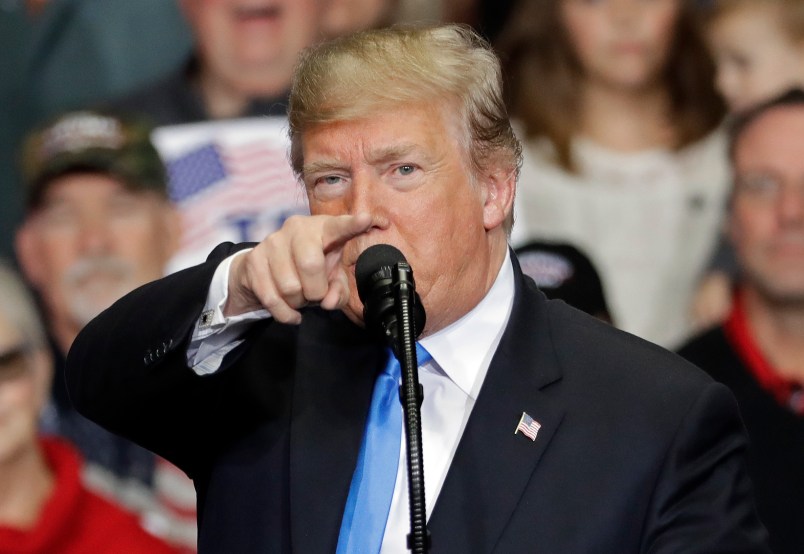The 2018 midterm elections reaffirmed the deep polarization inflicting America rather than producing a clear wave, with Democrats sweeping to a House majority by pulverizing suburban Republicans as the GOP trounced a number of red-state Democratic incumbents to tighten their hold on the Senate.
A huge surge in turnout from partisans on both sides showed that the wrenching, emotional state of modern politics has everyone fired up. Votes are still being counted in the 2018 midterms, but it’s clear that turnout shattered that seen in both 2014 and 2010, and in some states looked more like presidential than midterm years.
The split decision seems likely to further embolden President Trump to amp up his harsh and bombastic campaign going forward, after his harsh anti-immigrant closing message and the fraught fight to confirm Supreme Court Justice Brett Kavanaugh appear to have helped seal the deal for the GOP in the Senate even as it boosted Democrats in the House.
“Tremendous success tonight. Thank you to all!” Trump tweeted late Tuesday evening.
Republicans got their clocks cleaned in almost every suburban pocket of the country. Longtime GOP power-players including House Rules Committee Chairman Pete Sessions (R-TX) and House Ways & Means Committee subcommittee chairman Peter Roskam (R-IL) lost reelection bids in districts that have rapidly swung away from their party. A number of GOP incumbents who were barely on strategists’ radars got upset as well, including Reps. Dan Donovan (R-NY) on Staten Island and Steve Russell (R-OK) in Oklahoma City. Democrats were just short of a 30-seat House pickup as of 2:30 a.m. ET, with a number of close races in California yet to be called.
Winning the House is a huge victory for Democrats. But they also saw their fragile red-state Senate coalition fall apart amidst intense partisan polarization, a dangerous pattern for their hopes of winning Senate control anytime soon. They lost incumbents in three deep-red Trump states as well as Florida, which looks once again like the party’s back-breaker, with results still unclear in Montana and Arizona.
Democrats did pick up their sole target in a state Trump lost, with Rep. Jacky Rosen (D-NV) defeating Sen. Dean Heller (R-NV). But Arizona, their other top target, remained too close to call early Wednesday morning, and Sen. Jon Tester (D-MT) was in an even tighter race against Montana state Auditor Matt Rosendale (R) than Democrats had feared in the race’s closing weeks.
Democrats also lost a heartbreakingly close governor’s race in Florida as well as in Iowa, with Republicans pulling off a surprisingly comfortable win in Ohio — some of the same swing states that swung to President Trump in 2016 to help hand him the presidency.
Trump won 30 of the 50 states in his 2016 election and Democrats’ Senate strength has long been built on holding enough seats in smaller red states to keep in contention, so the further the map becomes polarized the more difficult it will become for Democrats to compete for the upper chamber.
It was a bad night for moderates in both parties, as a number of suburban Republicans who’d opposed their party on issues like immigration and their Obamacare repeal went down hard, and red-state Democratic senators started looking increasingly like an endangered species.
Democrats did make inroads into a lot of light red territory, driving their solid House gains with wins over incumbents like Donovan, Russell and Rep. Randy Hultgren (R-IL). They also scored big gubernatorial wins in Michigan and Wisconsin, while crushing the GOP in Pennsylvania’s statewide races — the three states that put Trump in the White House.
But even in the House, this polarization was obvious. Republicans won a number of tight races in heavily conservative territory where both parties expended huge amounts of money, with Reps. Andy Barr (R-KY) and Mike Bost (R-IL) hanging on against two of Democrats’ best recruits in the country and Democrats falling short in the open seat in rural Kansas they’d felt confident they’d win.
The Senate side was much uglier for Democrats. They lost three of the five states that Trump won comfortably while dropping a Senate race in Florida they thought they had in hand heading into Election Day. There were some silver linings, with Sen. Joe Manchin (D-WV) hanging on in a solidly Trump state and Sens. Debbie Stabenow (D-MI), Sherrod Brown (D-OH), Bob Casey (D-PA) and Tammy Baldwin (D-WI) all winning reelection in states Trump won.
But the most striking thing about 2018 is how much it looked like 2016. Democrats fell just short in Florida and lost Ohio’s governorship (even as Brown won). The same outraged polarization that fueled Trump’s skin-of-his-teeth victory in 2016 continues to manifest itself across the map.
The best news for Democrats besides the big House flip came in the trio of states Trump barely won to land him in the White House. In Michigan, Wisconsin and Pennsylvania, Democrats won both the governorship and Senate races.
But it’s clear that while a lot of voters are furious at Trump right now, because of Democrats’ structural disadvantages (too many Democrats in too few heavily blue states, and gerrymandering and Democrats’ clustering in urban areas in the House), their battle to wrest control of the country has found mixed results in the midterms, with a murky future heading into Trump’s reelection.
Outgoing Speaker Paul Ryan (R-WI) eulogized the results.
“We don’t need an election to know that we are a divided nation, and now we have a divided Washington. As a country and a government we must find a way to come together to find common ground and build on the successes of this Congress,” he said in a statement.
But Ryan’s leaving. His majority is gone. His more genteel brand of politics appear to be a thing of the past. And Washington — and the country — look more polarized than ever before.










